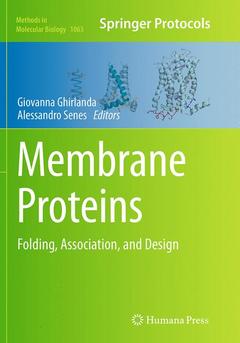Description
Membrane Proteins, 2013
Folding, Association, and Design
Methods in Molecular Biology Series, Vol. 1063
Coordinators: Ghirlanda Giovanna, Senes Alessandro
Language: English
Subjects for Membrane Proteins:
Publication date: 08-2016
Support: Print on demand
Publication date: 08-2013
246 p. · 17.8x25.4 cm · Hardback
Description
/li>Contents
/li>Comment
/li>
Focusing on model systems for the study of structure, folding, and association in the membrane, Membrane Proteins: Folding, Association, and Design presents an overview of methods that can be applied to these intricate systems. The volume is divided into four detailed sections, covering association of transmembrane helices, interactions with the lipid bilayer, NMR methods, as well as a variety of engineering approaches. Written for the highly successful Methods in Molecular Biology series, chapters include introductions to their respective topics, lists of the necessary materials and reagents, step-by-step, readily reproducible laboratory protocols, and tips on troubleshooting and avoiding known pitfalls.
Authoritative and practical, Membrane Proteins: Folding, Association, and Design serves as an ideal guide for researchers reaching for the tantalizing possibility of designing novel membrane proteins with tailored functionality.
Use of Thiol-Disulfide Exchange Method to Study Transmembrane Peptide Association in Membrane Environments.- Measurement of Transmembrane Peptide Interactions in Liposomes Using Förster Resonance Energy Transfer (FRET).- Measuring Transmembrane Helix Interaction Strengths in Lipid Bilayers Using Steric Trapping.- Genetics Systems for Monitoring Interactions of Transmembrane Domains in Bacterial Membranes.- Analyzing the Effects of Hydrophobic Mismatch on Transmembrane α-Helices Using Tryptophan Fluorescence Spectroscopy.- Folding Alpha Helical Membrane Proteins into Liposomes In Vitro and Determination of Secondary Structure.- Solvation Models and Computational Prediction of Orientations of Peptides and Proteins in Membranes.- Membrane Protein Structure Determination: Back to the Membrane.- On the Role of NMR Spectroscopy for Characterization of Antimicrobial Peptides.- Prediction and Design of Outer Membrane Protein-Protein Interactions.- Design of Transmembrane Peptides: Coping with Sticky Situations.- Engineering and Utilization of Reporter Cell Lines for Cell-Based Assays of Transmembrane Receptors.- Fluorination in the Design of Membrane Protein Assemblies.




